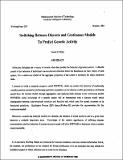| dc.contributor.author | Weld, Daniel S. | |
| dc.date.accessioned | 2008-04-22T11:12:07Z | |
| dc.date.available | 2008-04-22T11:12:07Z | |
| dc.date.issued | 1983-10 | |
| dc.identifier.uri | http://hdl.handle.net/1721.1/41208 | |
| dc.description.abstract | Molecular biologists use a variety of models when they predict the behavior of genetic systems. A discrete model of the behavior of individual macromolecular elements forms the foundation for their theory of each system. Yet a continuous model of the aggregate properties of the system is necessary for many predictive tasks.
I propose to build a computer program, called PEPTIDE, which can predict the behavior of moderately complex genetics systems by performing qualitative simulation on the discrete model, generating a continuous model from the discrete model through aggregation, and applying limit analysis to the continuous model. PEPTIDE's initial knowledge of a specific system will be represented with a discrete model which distinguishes between macromolecule structure and function and which uses five atomic processes as its functional primitives. Qualitative Process (QP) theory [Forbus 83] provides the representation for the continuous model.
Whenever a system has multiple models of a domain, the decision of which model to use in a given time becomes a critically important issue. Knowledge of the relative significance of differing element concentrations and the behavior of process structure cycles will allow PEPTIDE to determine when to switch reasoning modes. | en |
| dc.description.sponsorship | MIT Artificial Intelligence Laboratory | en |
| dc.language.iso | en_US | en |
| dc.publisher | MIT Artificial Intelligence Laboratory | en |
| dc.relation.ispartofseries | MIT Artificial Intelligence Laboratory Working Papers, WP-255 | en |
| dc.title | Switching Between Discrete and Continuous Models To Predict Genetic Activity | en |
| dc.type | Working Paper | en |
